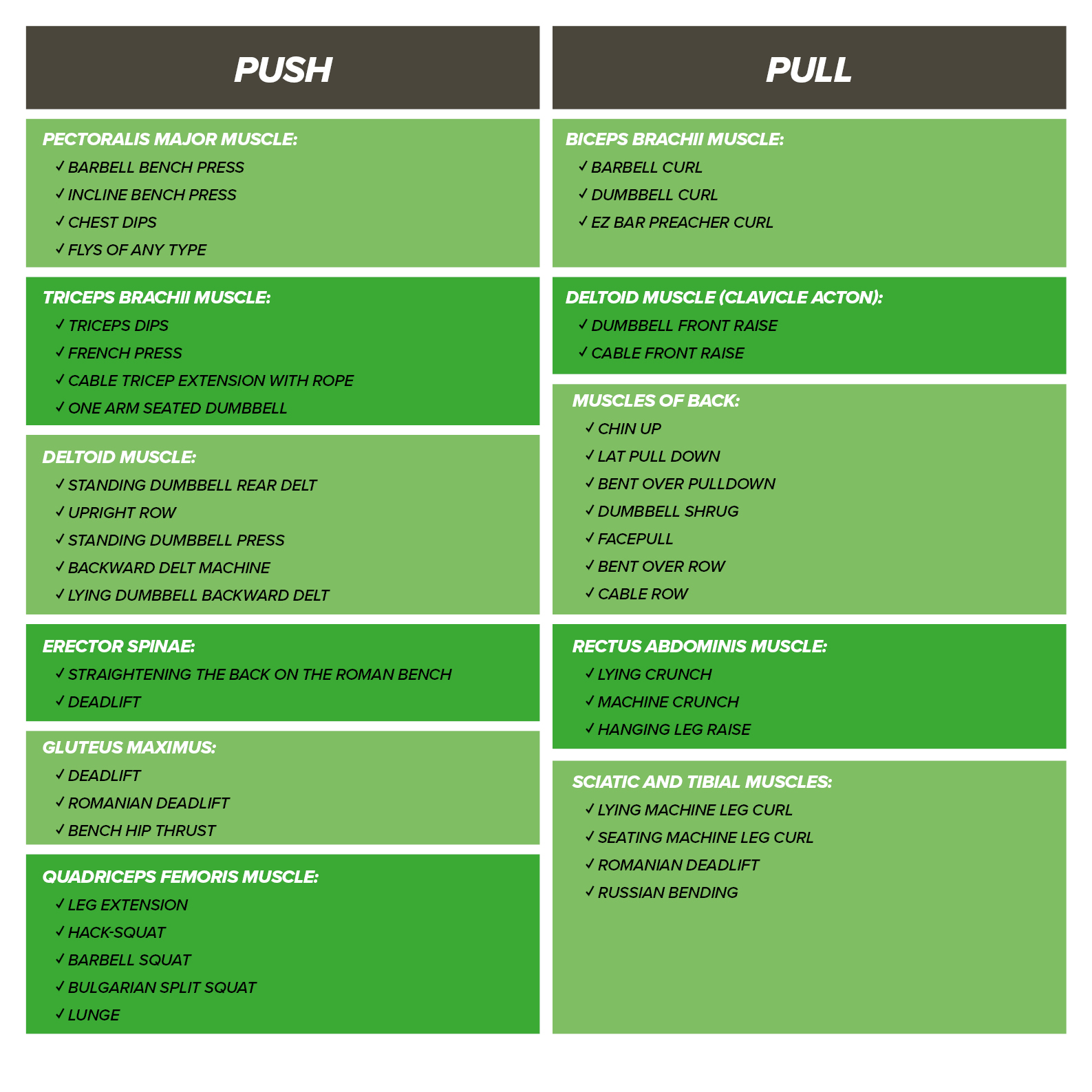Are you an intermediate or advanced person and are you thinking about changing your training plan? Have you gone through a half-year, monotonous FBW? Have you completed the annual internship on "split"? Are you looking for new tools and solutions to further work on the figure that will allow you to grow without limits? Therefore, you must know the "PUSH & PULL" strategy. I will guide you through all the nuances of this plan and teach you how to create your own and unique patterns.
Special features
The name of this approach to training comes from two English words: push - push and pull - pull. Pushing movements are movements occurring with the use of extensor muscles (straightening the joints), which include: triceps brachii, deltoid muscle (pectineus and acromial), pectoralis major, erector spinae, gluteus maximus and quadriceps femoris. Pulling movements are movements made using flexor muscles (bending joints), which include: biceps, deltoid muscle (clavicle acton), latissimus dorsi, quadratus femoris, teres major and minor, rectus abdominis, iliolumbar, sciatic and tibial muscles, calf brachii.

Knowledge of the division of our body into straightening and flexor muscles allows us to design the training cleverly in such a way as to provide ourselves with optimal time for regeneration. Thanks to the push & pull system, we can even train every muscle part twice a week, ensuring at the same time a sufficiently long rest before the next training session. Stimulation of our muscles twice a week allows for increased and more frequent protein synthesis than is the case in SPLIT training. It also outperforms FBW where, despite the fact that stimulation occurs three times a week, in FBW we perform only one or two exercises for a given muscle part, while in push & pull up to 5 exercises. Stimulation is therefore incomparably heavier over the course of a week, and the training volume (the total number of raised kg per training) is much higher, which causes a more intense growth of muscle tissue. However, if your diet leaves much to be desired, you sleep poorly and struggle with high levels of stress, forget about starting this training system. Push & pull should be treated as a training camp. If you sleep every day min. 8 hours, your diet is buttoned up and is characterized by high nutritional and energy value (high carbohydrate content) and does not bother your head, and your only worry is training in the gym you can try. I warn you that conscientiously worked several months in this system can bring you spectacular body results.
Planning training
After a short anatomy lesson and learning the required conditions, it is time to choose the exercises and put them into a training plan. Below I have prepared for you a list of the most valuable exercises divided into push and pull exercises:

Other muscles that do not qualify for the division of push & pull due to the nature of their work such as: adductor muscles, gluteus medius can be added in the plan where they fit the most.
Knowing exactly the division of muscle groups and exercises in the push & pull system, we can get to plan for the whole week. Let's take an advanced level - training 6 times a week, each muscle party is stimulated twice a week, one day of rest. Let the training camp start now!

The table above presents a hybrid system of exercised muscle groups during one week. The classic push & pull is just a push exercises one day and the other pull exercises. The advantage of the hybrid over the classic program is that you are also able to train larger muscle joints together (that is why, for example, legs are made all over one workout without being divided into push and pull). This is the only way that any muscle party can be worked twice during the week. If necessary, you can divide the legs training in this case on: Tuesday - quadriceps and Friday – sciatic and tibial and calves. To fill the above plan with exercises you will need a lot of imagination and panache. The training of each muscle part takes place twice a week and it is good to stimulate each session in a different way. For example, if during one session on the chest you perform:
1. barbell bench press,
2. incline bench dumbbell press,
3. dumbbell flyes;
on the second day you should completely shock the body by doing, for example:
1. incline bench barbell press,
2. dips,
3. flyes in the gate.
You must therefore put together 6 different training plans for 6 sessions. This variety of exercises will not allow your muscle tissue to get used to one stimulus as it will be constantly attacked from all sides! So many variations of exercises, a wisely planned schedule and double stimulation over the course of a week will lead you to previously unknown areas in the work on the figure.





